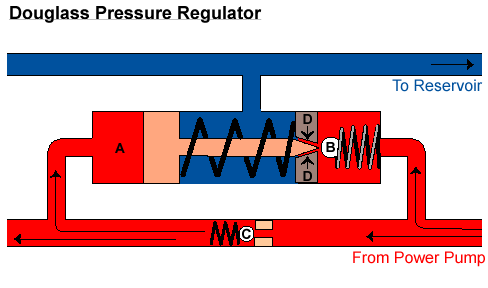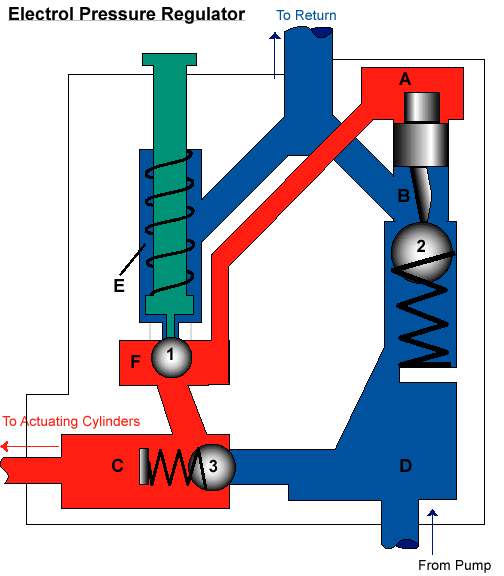 |
|||||
| Home | Research | For Teachers | HISTORY Level 1 Level 2 Level 3 |
PRINCIPLES Level 1 Level 2 Level 3 |
CAREER Level 1 Level 2 Level 3 |
| Gallery | Hot Links | What's New! | |||
| Web Administration and Tools | |||||
 |
|||||
| Home | Research | For Teachers | HISTORY Level 1 Level 2 Level 3 |
PRINCIPLES Level 1 Level 2 Level 3 |
CAREER Level 1 Level 2 Level 3 |
| Gallery | Hot Links | What's New! | |||
| Web Administration and Tools | |||||
![]()
If a system relief valve (SRV) were used to regulate pressure, it would have to be replaced in a very short time. This would be due to the overuse of the SRV and the failure of the spring's elasticity. If the SRV were used, the oil pushing on the spring-ball combination would cause tremendous vibrations and heat would be dissipated by the oil under high pressure attempting to push the ball away from the seat to get to the low pressure side.

When an actuating cylinder finishes its motion and stops, a high pressure will be felt
through the system. If so, this high pressure oil coming from the power pump (right side
of diagram) will keep check valve C open and also act on piston A. In its movement, piston
A pushes Ball B off seat D. The oil, taking the passage of least resistance, goes through
passage D into the center chamber (colored blue) back to the reservoir. The pressure on
the right side of check valve C will drop and will be less than the pressure on the left
side of C, therefore, causing the ball to seat itself in check valve C. When the hydraulic
system pressure drops, the pressure on piston A decreases, causing a decrease in pressure
on B as well. The path of least resistance through D will close and the oil will move in
the direction towards check valve C. Now, because the pressure on the right side of C is
greater than on the left of C, the check valve will be forced open and the oil will move
toward the selector valve side of the system (left side of diagram).
The range of operation of the pressure regulator is defined by the difference in force
required for bypass and the force required at actuation.
Electrol Pressure Regulator

The dual purpose of a pressure regulator is to reduce the load on the hydraulic pump when not needed and to keep the hydraulic pressure within the operating range of the hydraulic system.
When the hydraulic pump is charging the system, balls 1 and 2 are seated on their seats
but ball 3 is letting oil pass through to the actuating cylinders. When actuation stops,
the pressure in the system builds to maximum. The spring holding ball 1 onto the lower
seat is designed to withstand the force produced by the maximum pressure of the hydraulic
system. As maximum pressure is reached, ball 1 is made to move to the upper seat, thereby
letting high pressure oil reach the A side of piston. But, ball 3 has already moved to its
seat due to the higher pressure felt on side C than on side D. Therefore, oil coming from
the hydraulic pump is at a charging pressure less than the maximum pressure of side A of
the piston, causing the piston to move down, in turn pushing ball 2 down. Oil, wanting to
take the path of least resistance, goes by ball 2 to the return line.
If actuation restarts, then pressures at C side of ball 3, at A side of piston and at F
side of ball 1 decreases. Ball 1 falls onto the lower seat, since the spring force is
greater than the force generated by the hydraulic system's oil pressure. Piston A will
then move up due to the pressure drop on side A, causing ball 2 to close the orifice to
the return line. The oil being pumped from the hydraulic pump now has greater pressure on
side D of ball 3, causing the ball to move to the left and the hydraulic system oil goes
in the direction of the actuating cylinder.
The range of operation depends on ball 1. As you can see, if the force of the spring holding ball 1 is to be overcome, a certain pressure (equal to the spring force divided by the opening's cross-sectional area) at the lower seat would be needed. If the ball were to move upward to the upper seat, the exposed surface area of the ball on which the pressure acts would increase (while the spring force would essentially remain the same) thereby causing the pressure in the system to decrease. Ball 1 would then move from the lower seat to the upper seat very quickly as more surface area is exposed, causing the pressure required to move the ball to drop. When the pressure delivered is much higher than the pressure required to move the ball, then the ball will move quickly and bang shut against the upper seat. The opposite reaction occurs when the pressure in the system is lowered to within operational limits.
Send all comments to ![]() aeromaster@eng.fiu.edu
aeromaster@eng.fiu.edu
© 1995-98 ALLSTAR Network. All rights reserved worldwide.
Updated: February 17, 1999